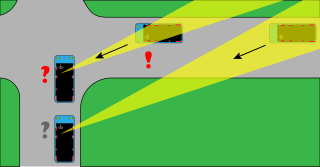
A semi-trailer truck, is the combination of a tractor unit and one or more semi-trailers to carry freight. A semi-trailer attaches to the tractor with a type of hitch called a fifth wheel.

A road train, also known as a land train or long combination vehicle (LCV) is a semi-truck used to move road freight more efficiently than single-trailer semi-trucks. It consists of one semi-trailer or more connected together with or without a tractor.

In transportation, platooning or flocking is a method for driving a group of vehicles together. It is meant to increase the capacity of roads via an automated highway system.

Automotive safety is the study and practice of automotive design, construction, equipment and regulation to minimize the occurrence and consequences of traffic collisions involving motor vehicles. Road traffic safety more broadly includes roadway design.

Road traffic safety refers to the methods and measures used to prevent road users from being killed or seriously injured. Typical road users include pedestrians, cyclists, motorists, vehicle passengers, and passengers of on-road public transport.

Volvo Cars is a Swedish multinational manufacturer of luxury vehicles. Volvo is headquartered in Torslanda, Gothenburg. The company manufactures SUVs, station wagons, and sedans. The company's main marketing revolves around safety and its Swedish heritage and design.

Electronic stability control (ESC), also referred to as electronic stability program (ESP) or dynamic stability control (DSC), is a computerized technology that improves a vehicle's stability by detecting and reducing loss of traction (skidding). When ESC detects loss of steering control, it automatically applies the brakes to help steer the vehicle where the driver intends to go. Braking is automatically applied to wheels individually, such as the outer front wheel to counter oversteer, or the inner rear wheel to counter understeer. Some ESC systems also reduce engine power until control is regained. ESC does not improve a vehicle's cornering performance; instead, it helps reduce the chance of the driver losing control of the vehicle.

A blind spot in a vehicle or vehicle blind spot is an area around the vehicle that cannot be directly seen by the driver while at the controls, under existing circumstances. In transport, driver visibility is the maximum distance at which the driver of a vehicle can see and identify prominent objects around the vehicle. Visibility is primarily determined by weather conditions and by a vehicle's design. The parts of a vehicle that influence visibility include the windshield, the dashboard and the pillars. Good driver visibility is essential to safe road traffic.

Telematics is an interdisciplinary field encompassing telecommunications, vehicular technologies, electrical engineering, and computer science. Telematics can involve any of the following:

A rollover or overturn is a type of vehicle crash in which a vehicle tips over onto its side or roof. Rollovers have a higher fatality rate than other types of vehicle collisions.

Vehicular automation involves the use of mechatronics, artificial intelligence, and multi-agent systems to assist the operator of a vehicle such as a car, lorries, aircraft, or watercraft. A vehicle using automation for tasks such as navigation to ease but not replace human control, qualify as semi-autonomous, whereas a fully self-operated vehicle is termed autonomous.

Adaptive cruise control (ACC) is a type of advanced driver-assistance system for road vehicles that automatically adjusts the vehicle speed to maintain a safe distance from vehicles ahead. As of 2019, it is also called by 20 unique names that describe that basic functionality. This is also known as Dynamic cruise control.

The Eureka PROMETHEUS Project was the largest R&D project ever in the field of driverless cars. It received €749,000,000 in funding from the EUREKA member states, and defined the state of the art of autonomous vehicles. Numerous universities and car manufacturers participated in this Pan-European project.
Intelligent speed assistance (ISA), or intelligent speed adaptation, also known as alerting, and intelligent authority, is any system that ensures that vehicle speed does not exceed a safe or legally enforced speed. In case of potential speeding, the driver can be alerted or the speed reduced automatically.

An armored vehicle is an armored van or truck used to transport valuables, such as large quantities of money or other valuables, especially for banks or retail companies. The armored car is typically a multifunctional vehicle designed to protect and ensure the wellbeing of the transported contents and guards. Typically customized on a basic van or truck chassis, they feature bullet-resistant glass, armor plating, and reinforced shells and cabs. Armored cars are designed to resist attempts at robbery and hijacking, being able to withstand bullets from most handguns and rifles, as well as extreme degrees of heat, explosives, and collisions.

A collision avoidance system (CAS), also known as a pre-crash system, forward collision warning system (FCW), or collision mitigation system, is an advanced driver-assistance system designed to prevent or reduce the severity of a collision. In its basic form, a forward collision warning system monitors a vehicle's speed, the speed of the vehicle in front of it, and the distance between the vehicles, so that it can provide a warning to the driver if the vehicles get too close, potentially helping to avoid a crash. Various technologies and sensors that are used include radar (all-weather) and sometimes laser (LIDAR) and cameras to detect an imminent crash. GPS sensors can detect fixed dangers such as approaching stop signs through a location database. Pedestrian detection can also be a feature of these types of systems.

Experiments have been conducted on self-driving cars since 1939; promising trials took place in the 1950s and work has proceeded since then. The first self-sufficient and truly autonomous cars appeared in the 1980s, with Carnegie Mellon University's Navlab and ALV projects in 1984 and Mercedes-Benz and Bundeswehr University Munich's Eureka Prometheus Project in 1987. Since then, numerous major companies and research organizations have developed working autonomous vehicles including Mercedes-Benz, General Motors, Continental Automotive Systems, Autoliv Inc., Bosch, Nissan, Toyota, Audi, Volvo, Vislab from University of Parma, Oxford University and Google. In July 2013, Vislab demonstrated BRAiVE, a vehicle that moved autonomously on a mixed traffic route open to public traffic.
Peloton Technology was an American automated and connected vehicle technology company established in 2011 and headquartered in Mountain View, California. It primarily developed a vehicle "platooning" system to enable pairs of trucks to operate at close following distances with a stated goal of improving safety and fuel efficiency. Peloton Technology was the first company to test a non-research commercial truck platooning system on public roads in the United States. In 2016 it publicly stated it would be the first company to offer a commercial platooning system for use by truck fleets in 2017. By mid-2018 that deadline had slipped to "by the end of 2018."
The Conference of European Directors of Roads (CEDR) or Conférence Européenne des Directeurs des Routes was created in 2003 from the former Western European Road Directors (WERD). It is a non-profit organisation established as a platform for the Directors of National Road Authorities. Having a European focus, CEDR complements the work of the World Road Association PIARC and other regional associations of road authorities. CEDR's activities are carried out in an open and transparent way in accordance with CEDR's own code of conduct and the code of conduct of the EU institutions. CEDR's is listed in the EU Transparency Register, 485630615462–79.

A self-driving truck, also known as an autonomous truck or robo-truck, is an application of self-driving technology aiming to create trucks that can operate without human input. Alongside light, medium, and heavy-duty trucks, many companies are developing self-driving technology in semi trucks to automate highway driving in the delivery process.
















